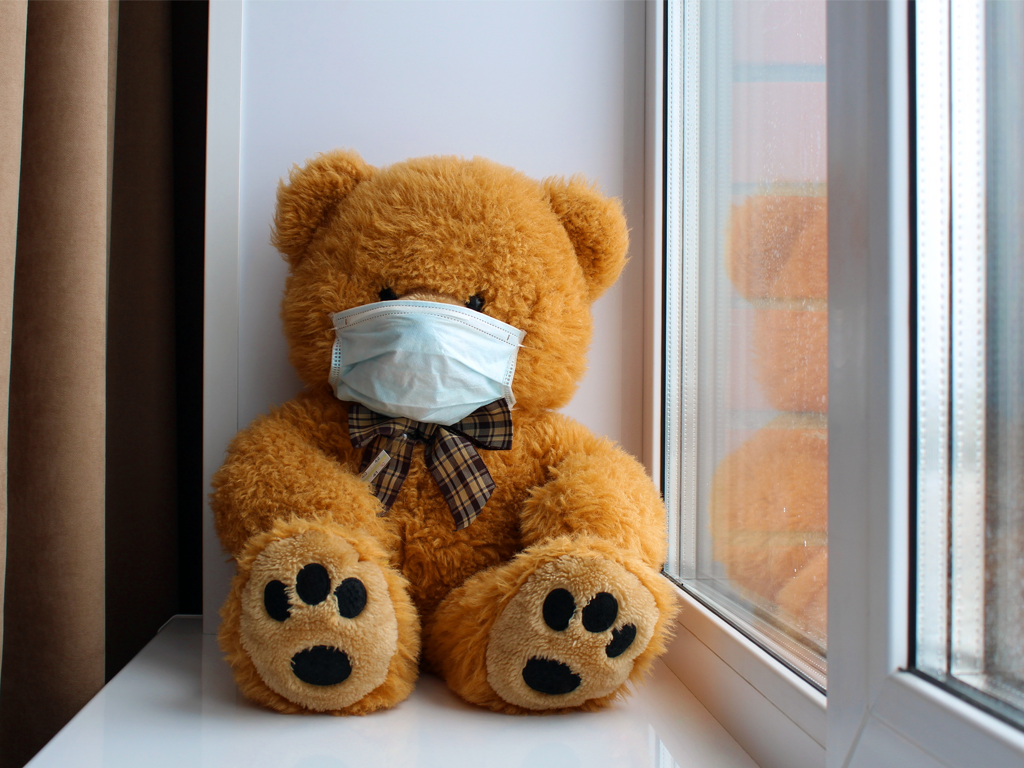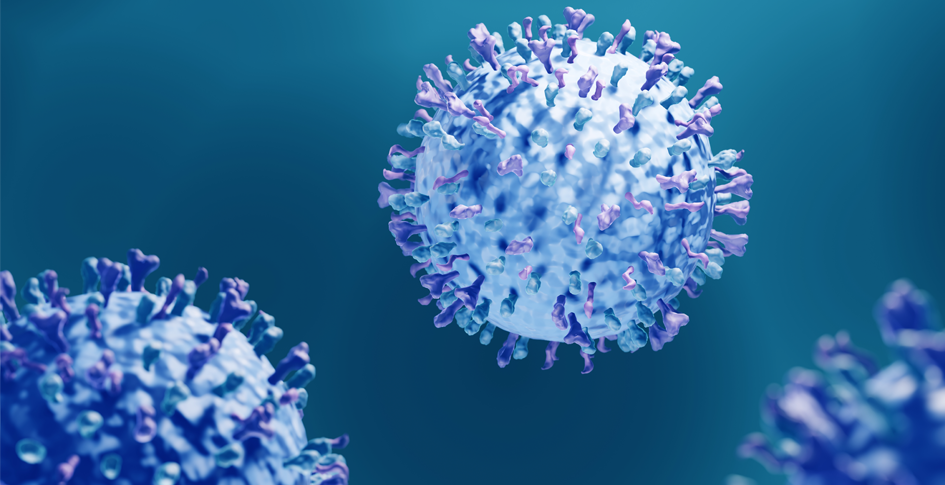After decades of RSV being an acronym known mostly to new parents and healthcare workers, it has recently gained publicity as a headline. We will briefly explain what RSV is, why it's making the news, and what your organization can do to reduce transmission.
What is RSV?
RSV stands for “Respiratory Syncytial Virus.” (“Syncytial” refers to the fact cells infected with the virus sometimes merge). It may also be referred to as the human orthopneumovirus. Like COVID-19 and influenza, RSV is an enveloped RNA virus. As a member of the paramyxoviridae family, it is distantly related to mumps and measles.
Together with its distant cousin parainfluenza, RSV accounts for about 20% of colds. And for most people, that's all it is—one of the many circulating viruses which cause the common cold. Most children have it at least once by the age of 2, and adults can be reinfected throughout life.
However, because it may infect the lungs' smallest pathways, RSV can sometimes turn from a nuisance into a threat. According to the CDC, “RSV is the most common cause of bronchiolitis (inflammation of the small airways in the lung) and pneumonia (infection of the lungs) in children younger than 1 year of age in the United States.” This can be especially problematic for premature infants. Per an article in Scientific American:
Premature infants’ lungs tend to be underdeveloped and even less capable of handling the inflammation caused by the virus. In fact, children who meet strict criteria for being at highest risk are recommended to receive the preventive antibody medication palivizumab as an injection into the thigh muscle once a month when RSV is circulating.
None of this, however, is news. While the specter of RSV may justifyingly distress the parents of young children, the virus is hardly headline material. However, that's beginning to change.
 RSV is especially difficult for children due to their small lung size. (Image credit: Getty / Snezhana Kudryavtseva)
RSV is especially difficult for children due to their small lung size. (Image credit: Getty / Snezhana Kudryavtseva)
Why is RSV in the News?
There are 4 reasons RSV is getting press:
1. RSV is More Dangerous than Commonly Thought
Despite its reputation as a childhood disease (about 2% of children infected are hospitalized), researchers are finding that RSV can be disruptive at all ages. According to data collected in the aforementioned Scientific American article, RSV hospitalizes 58,000 American children per year; however, fewer than 1% of these hospitalized children die. Meanwhile, RSV hospitalizes 177,000 adults per year, of which 14,000 (or 8%) die. This death rate places a ‘common cold’ virus on par with a mild flu season!
Other research supports this flu comparison. Per a 2017 summary of the field of RSV research, RSV is dangerous to a variety of different groups:
- Elderly adults: “[...]elderly patients who were positive for RSV infection were twice as likely to be hospitalized as the patients who were positive for [the] influenza A virus.”
- Transplant patients: “Some recent studies have identified a 30 to 100% mortality rate due to RSV infection in solid organ and bone marrow transplant recipients.”
- Impoverished countries: “[...]in 2005, between 66,000 and 160,000 children less than 5 years of age died of RSV infection or of complications directly related to RSV infection[...]The majority of these deaths occurred in developing countries.”
2. COVID-19 Broke RSV's Seasonality
RSV spikes usually occur yearly during flu season. However, due to COVID-19 precautions, many children successfully avoided exposure to RSV for a year and a half. When the world began to roll back COVID precautions in the summer of 2021, RSV surged out of season. It has yet to fully resume its seasonal pattern.
3. 2022 is a Particularly Bad Year for RSV Cases
At the time this article is being written (mid-November 2022), RSV cases are higher than they should be. According to a CNN article, “In the years before the COVID-19 pandemic, hospitalization rates [due to RSV] for seniors were about 10 times lower at this point in the season.” Similarly, an expert told Today.com that:
“‘RSV has arrived much earlier than is usual, and the numbers of cases are increasing very rapidly [...]In parts of the U.S., the numbers of hospitalized children are already similar to what we would typically see around mid to late December, and are still increasing.”’
4. The Healthecare System is Already Overburdened
Entering the 2022-2023 flu season, healthcare facilities are still dealing with staffing shortages from the effects of the pandemic. We might see RSV, COVID-19, and influenza all converging on our hospitals at once this winter—a “tripledemic.”
How Your Organization Can Reduce RSV Transmission
Though the FDA has yet to approve a vaccine for RSV, several in development show promising results. However, as RSV mutates like every other respiratory virus, a vaccine will only reduce—not eliminate—the risks of RSV. Thus, here are 3 practices your organization can use to reduce RSV transmission.
1. Encourage employees to get their flu shots
While a flu shot won't stop your employees from getting RSV, it will reduce their risk of becoming severely ill with the flu. This results in one less staffing pressure for you to worry about during the “tripledemic.” (COVID-19 vaccines also have the same benefit to your organization.) Plus, vaccines reduce pressure on the healthcare system as a whole—helping doctors and nurses get care where it is needed most.
2. Follow the same precautions you would for any respiratory virus
You know the drill: Encourage frequent handwashing, cover your mouth when you sneeze or cough, and stay home when sick yourself. Create a culture where it is acceptable to use paid sick days (even for a cold) so that employees don't come into work sick to infect others. Masking indoors where appropriate may also reduce transmission.
3. Don't be fooled by the “droplet dogma”
According to official guidance, RSV spreads through close contact with virus-laden droplets from the coughs or sneezes of infected individuals. However, this theory of transmission (nicknamed the ‘droplet dogma’) is an incomplete understanding of how many respiratory viruses spread. While close contact is riskier than distance, recent studies have shown that COVID-19 and influenza spread through aerosols (airborne particles), not droplets. Considering that these two similar respiratory viruses spread through the air, research may eventually prove that RSV does as well, but the question remains open. A 2021 study found little evidence of the virus 6 feet beyond infected infants, while a 2016 study did find that infants expel aerosols.
If RSV is proven to spread through the air, then a layered prevention strategy may require indoor air treatment. We expect active air treatments such as ActivePure (proven to reduce 99.99% of many enveloped viruses) will become an essential component of every public building's infrastructure in a post-COVID world.
Help Your Business Avoid the “Tripledemic”
COVID-19 has forced us to look more closely at respiratory infections, and as a result, our understanding of RSV is beginning to change. What was once a minor nuisance is now known to be a strain on our healthcare system nearly on par with influenza—one not currently beholden to seasonal predictability.
RSV may not be a crisis compared to COVID-19, but it does require a change in our thinking. Society needs to consider every respiratory infection a failure of our buildings’ infrastructure. In addition to existing precautions, we need to make indoor air treatment as common as municipal water treatment. Fortunately, ActivePure is doing just that. Schools, gyms, arenas, restaurants, offices, stores, and homes in over 45 countries trust ActivePure to protect their air and surfaces.



